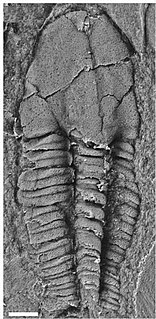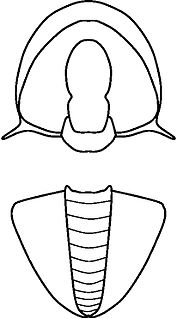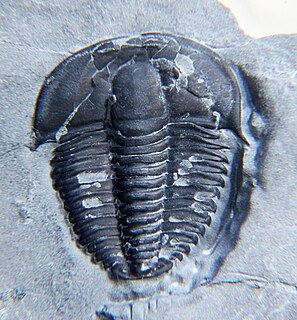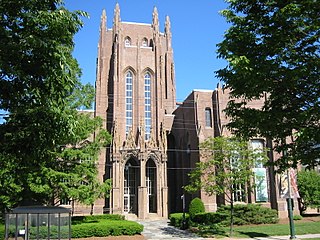Neoplagiaulax is a mammal genus from the Paleocene of Europe and North America. In the case of the latter continent, there may possibly be some slightly earlier, Upper Cretaceous material too. It existed in the age immediately following the extinction of the last dinosaurs. This animal was a member of the extinct order Multituberculata, lying within the suborder Cimolodonta and family Neoplagiaulacidae.
Mimetodon is a small mammal from the Paleocene of North America and perhaps Europe. It was a member of the extinct order Multituberculata within the suborder Cimolodonta and family Neoplagiaulacidae.

Charles Doolittle Walcott was an American paleontologist, administrator of the Smithsonian Institution from 1907 to 1927, and geologist. He is famous for his discovery in 1909 of well-preserved fossils, including some of the oldest soft-part imprints, in the Burgess Shale of British Columbia, Canada.

Othniel Charles Marsh was an American professor of Paleontology in Yale College and President of the National Academy of Sciences. He was one of the preeminent scientists in the field of paleontology. Among his legacies are the discovery or description of dozens of new species and theories on the origins of birds.

Biostratigraphy is the branch of stratigraphy which focuses on correlating and assigning relative ages of rock strata by using the fossil assemblages contained within them. The primary objective of biostratigraphy is correlation, demonstrating that a particular horizon in one geological section represents the same period of time as another horizon at a different section. Fossils within these strata are useful because sediments of the same age can look completely different, due to local variations in the sedimentary environment. For example, one section might have been made up of clays and marls, while another has more chalky limestones. However, if the fossil species recorded are similar, the two sediments are likely to have been laid down around the same time. Ideally these fossil are used to help identify biozones, as they make up the basic biostratigraphy units, and define geological time periods based upon the fossil species found within each section.

Conception Bay South is a town located on the southern shore of Conception Bay on the Avalon Peninsula of the island of Newfoundland, Province of Newfoundland and Labrador, Canada. The town is commonly called C.B.S.

Flexicalymene Shirley, 1936, is a genus of trilobites belonging to the order Phacopida, suborder Calymenina and Family Calymenidae. Flexicalymene specimens can be mistaken for Calymene, Gravicalymene, Diacalymene and a few other Calymenina genera. They are used as an index fossil in the Ordovician. Ohio and North America are particularly known for being rich with Flexicalymene fossils.

Agraulos Hawle & Corda 1847, is a genus of trilobites that lived during the Middle Cambrian in North America and Europe, particularly the Czech Republic.

Acidiscus Rasetti, 1966, is a genus of Eodiscinid trilobite belonging to the family Weymouthiidae Kobayashi T. (1943), Order Agnostida Salter (1864). It lived during the Botomian stage = late Lower Cambrian Stage 4 ; the upper Botomian boundary corresponds to base of the Middle Cambrian, Miaolingian Series and Wuliuan stage.
Beecher's Trilobite Bed is a Konservat-Lagerstätte of Late Ordovician (Caradoc) age located within the Frankfort Shale in Cleveland's Glen, Oneida County, New York, USA. Only 3-4 centimeters thick, Beecher's Trilobite Bed has yielded numerous exceptionally preserved trilobites with the ventral anatomy and soft tissue intact, the soft tissue preserved by pyrite replacement. Pyritisation allows the use of X-rays to study fine detail of preserved soft body parts still within the host rock. Pyrite replacement of soft tissue is unusual in the fossil record; the only Lagerstätten thought to show such preservation were Beecher's Trilobite Bed, the Devonian Hunsrück Slates of Germany, and the Jurassic beds of La Voulte-sur-Rhône in France, although new locations are coming to light in New York state.

Charles Emerson Beecher was an American paleontologist most famous for the thorough excavation, preparation and study of trilobite ventral anatomy from specimens collected at Beecher's Trilobite Bed. Beecher was rapidly promoted at Yale Peabody Museum, eventually rising to head that institution.
"Quiet, unassuming, modest in a very marked degree, simple, without affectation, entirely free from all eccentricities, conscientious and painstaking in every thing he had to do. In the words of Professor Chittenden, Director of the Sheffield Scientific School '.. .. to those who knew Professor Beecher intimately no words of appreciation will be deemed too extravagant, for close association only brought more clearly to view the many mental traits that testified to the strength of character and of mind that helped to make Professor Beecher one of the strong men of the Scientific School.' "

Mesonacis is an extinct genus of trilobite that lived during the Botomian, found in North-America, and the United Kingdom. Some of the species now regarded part of Mesonacis, have previously been assigned to Angustolenellus or Olenellus (Angustolenellus). Angustolenellus is now regarded a junior synonym of Mesonacis.
Lochmanolenellus is an extinct genus of trilobites, fossil marine arthropods, with one small species, L. mexicana. It lived during the Botomian stage (Olenellus-zone), 522–513 million years ago, in the South-West of the former continent of Laurentia, in what are today Mexico, and the South-Western United States.

Kendallina is a genus of trilobite with an inverted egg-shaped outline, a wide headshield, small eyes, small deflected spines, 12 thorax segments and a small, short tailshield. It lived during the Upper Cambrian in what are today Canada and the United States.

Serrodiscus Richter and Richter 1941. is a genus of Eodiscinid trilobite belonging to the family Weymouthiidae Kobayashi T. (1943), Order Agnostida. It lived during the late Lower Cambrian, with remains found in Canada, China (Gansu), The United Kingdom (England), Germany (Silesia), Poland, the Russian Federation, and the United States. It is named for the spines on the ventral side of the pygidium, which give it a serrated impression.

The Peabody Museum of Natural History at Yale University is among the oldest, largest, and most prolific university natural history museums in the world. It was founded by the philanthropist George Peabody in 1866 at the behest of his nephew Othniel Charles Marsh, the early paleontologist. Most known to the public for its Great Hall of Dinosaurs, which includes a mounted juvenile Brontosaurus and the 110-foot-long (34 m) mural The Age of Reptiles, it also has permanent exhibits dedicated to human and mammal evolution; wildlife dioramas; Egyptian artifacts; and the birds, minerals and Native Americans of Connecticut.
Christina Lochman-Balk was an American geologist who specialized in the study of Paleozoic era fossils, formerly known as Cambrian Paleontology. Lochman specifically dealt with Cambrian trilobites and invertebrates. During her career, it was not very common for women to pursue degrees or careers in geology, which was studied mostly by men. Along with her research, she also served as a lecturer and professor at the universities Mount Holyoke, University of Chicago and the New Mexico Institute of Mining and Technology. She received two degrees from Smith College in Northampton, Massachusetts in Geology, and her doctorate at Johns Hopkins University in 1933. She married Robert Balk in 1947, who was a geology professor at the University of Chicago. Following her husband's death in 1955, she became a full professor as well as appointed head of the geology department of the New Mexico Institute of Mining and Technology in 1957. She retired from her position in 1972.
Rhynchospira globosa is a Paleozoic articulate brachiopod of the Athyridida. It was discovered in 1857 by James Hall.
Uintasorex is a genus of primate which lived in North America during the Eocene epoch. Fossils belonging to Uintasorex have been dated to the Bridgerian and Uintan stages, roughly 50.3 to 42 million years ago.
Calodiscus is a genus of Eodiscinid trilobite in the family Calodiscidae. It lived during the late Lower Cambrian, with remains found in Canada, the United States, Greenland, The United Kingdom (England), Sweden, France, Germany, Italy (Sardinia), Kazakhstan, the Russian Federation and China.











